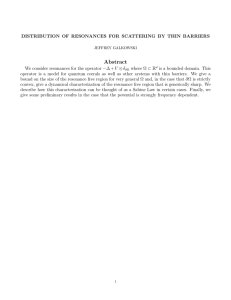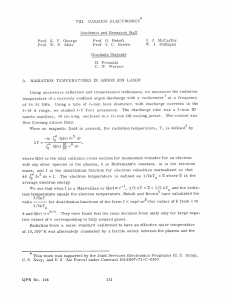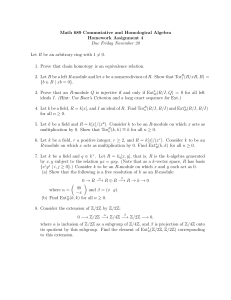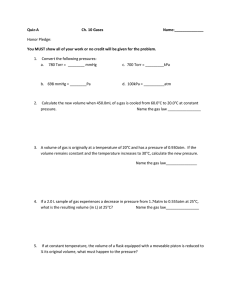VII. GASEOUS ELECTRONICS Academic and Research Staff
advertisement
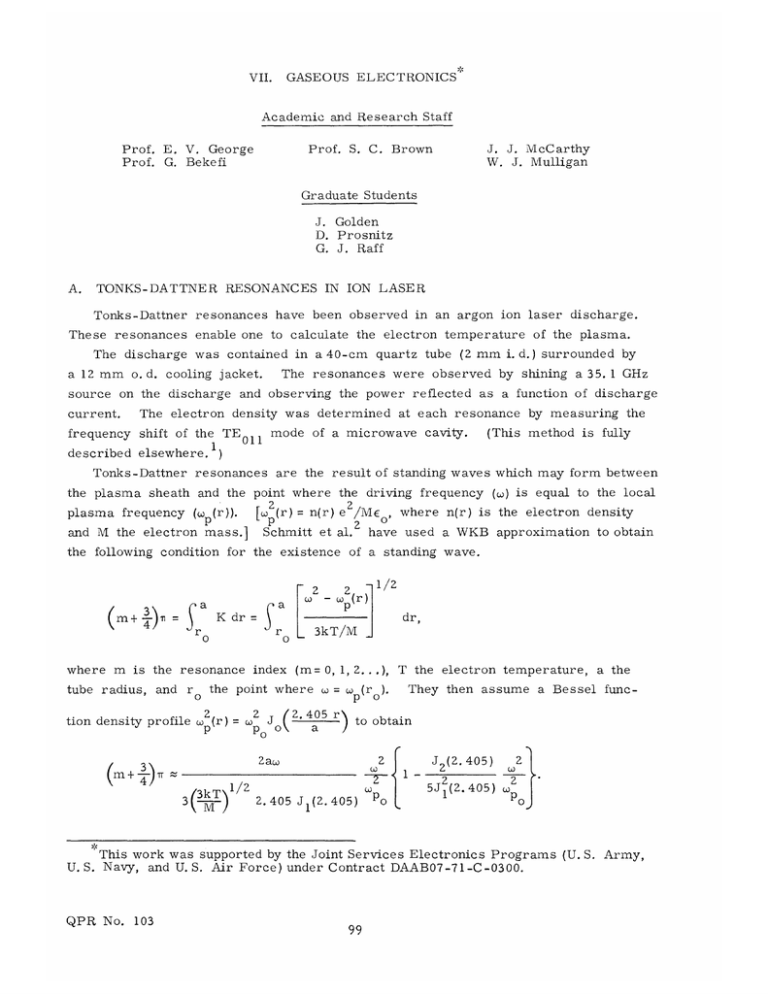
VII. GASEOUS ELECTRONICS Academic and Research Staff Prof. S. C. Prof. E. V. George Prof. G. Bekefi J. J. McCarthy W. J. Mulligan Brown Graduate Students J. Golden D. Prosnitz G. J. Raff A. TONKS-DATTNER RESONANCES IN ION LASER Tonks-Dattner resonances have been observed in an argon ion laser discharge. These resonances enable one to calculate the electron temperature of the plasma. The discharge was contained in a 40-cm quartz tube (2 mm i. d.) surrounded by a 12 mm o. d. cooling jacket. The resonances were observed by shining a 35. 1 GHz source on the discharge and observing the power reflected as a function of discharge The electron density was determined at each resonance by measuring the current. frequency shift of the TE011 mode of a microwave described elsewhere. Tonks-Dattner cavity. (This method is fully ) resonances are the result of standing waves which may form between the plasma sheath and the point where the driving frequency 2 2 = n(r) e 2/ME o plasma frequency (wp(r)).[ o (r) and M the electron mass.] Schmitt et al. , (w) is equal to the local where n(r) is the electron density have used a WKB approximation to obtain the following condition for the existence of a standing wave. (4-_\ m+ + = K ra ar K dr = a O where m 2- 2 1/ 2 Mpjr -- dr, O is the resonance index (m= 0, 1, 2...), T the electron temperature, tube radius, and ro the point where tion density profile w 2 (r)= o2 J( OPo (3kT 3 k) .40 a 5 r)to 2aw ( ) TrZ m+ 2 o = c p(r / 2.405 J 1 (2. 405) ). a the They then assume a Bessel func- obtain 2 Po 1- J 2 (2.405) 2 5J (2 .405) I " W_ o This work was supported by the Joint Services Electronics Programs (U. S. Army, U. S. Navy, and U. S. Air Force) under Contract DAAB07-71-C-0300. QPR No. 103 2 3 4 5 URRENT W (P), 6 9 7 CURFOO(A) Fig. VII-1. Tonks-Dattner. resonances in the reflection of an argon ion laser discharge. (a) 3. 0 Torr, (c) 4. 1 Torr. (b) 3. 5 Torr. (d) 4. 7 Torr. ARGON 25 O D + A 4.7 4.1 3.0 3.5 Torr Torr Torr Torr 2.2 2.6 3.5 2.7 eV eV, eV eV m RESONANCE INDEX Fig. VII-2. 2 plotted against the Tonks-Dattner resonance index. p The resonance spacing enables calculation of electron temperature. QPR No. 103 100 (VII. GASEOUS ELECTRONICS) The expression above may then be used to determine the electron temperature. Figure VII-1 shows the resonances as a function of discharge current. plotted against the resonance index m, ure VII-Z shows (o/( p )) p the average plasma frequency, p ME Here slope of these lines determined the designated electron temperature. The is ) e ( Z where (Lo p p Fig - we have assumed that W2 2 <<1." 5J (2.405) J 2 (2. 405) p 1 An instability in the discharge prevents us from obtaining a full range of resoFigure VII-3 shows the electron temperatures calculated nances at lower pressures. 8- 6 Fig. VII-3. S4 z U * Electron temperature of argon ion laser as calculated from m = 1 Tonks-Dattner resonance. 2 I 0 0 0.1 0.2 0.3 I 0.4 0.5 pr (Torr-cm) uing the single resonance for which the most data were available (m= 1). that this gives good qualitative It is seen agreement with Schottky theory. We realize that this method can only yield approximate figures for the electron temperature as all computations depend on the assumed density profile. A radiom- eter is being constructed so that more accurate temperature measurements may be made. D. Prosnitz, E. V. References 1. L. D. Pleasance and E. V. 2. H. J. Schmitt, G. Meltz, QPR No. 103 George, Appl. Phys. Letters 18, and P. G. Freyheit, Phys. 101 101 557-561 (1971). Rev. 139A 1432 (1965). George
